Cuisine of Carmarthenshire
Known as “The Garden of Wales”,[1] Carmarthenshire is a county of rich, fertile farmland and productive seas and estuaries, that give the county a range of foods that motivate many home cooks and restaurateurs.[2] There is a local tradition in brewing, milling, gathering shellfish from the coasts and in meat production.[3] Carmarthenshire has been described by The Daily Telegraph as a “worthwhile destination for foodies” with the county having a “modest matter of fact excellence”.[4] Carmarthenshire has ambitions to become the premier food-producing county of Wales, based on its strong reputation for first class products.[5] and Carmarthenshire County Council produces its own on-line and hard-copy recipe book called ‘Taste from Carmarthenshire’, for those interested in learning more about the county’s cuisine.[6]
Markets
Agriculture is an important industry in Carmarthenshire, and most people visit the busy market towns throughout the county. Each market operates a livestock sale on different days. Llanybydder has a normal mart held on Mondays, and a monthly horse sale on the last Thursday of the month.
.jpg)
Carmarthen is the county town, and has a full market on Wednesdays and Saturdays, but many stalls are permanent and open every day. The market is important for those wanting to purchase fresh local foods.[3] Carmarthen Market is now at the heart of the £74m St Catherine's Walk redevelopment scheme, which was completed in 2010.[7] and Carmarthen has been described as an authentic market town worth a second look.[4] Llanelli market is another busy county market, with more than 50 family run businesses.[7]
The farming year culminates with the Carmarthen Agricultural Show during the second week of August.[3] and The Three Counties Show held in August demonstrates the range of produce available, offering a range from whiskey to chocolate.[1]
Meat
Carmarthenshire's undulating land is prime dairy and mixed farming country, with lamb and beef both important. In his pastoral poem called Grongar Hill the poet John Dyer refers to the valley of the river Towy as follows:
Pressdee notes that a number of farms specialise in beef production from a range of British and Continental breeds, with Welsh Black becoming more popular, as in other Welsh regions, over recent years.[8]
Several organic farms have made an impact in the county, including Fferm Tyllwyd located at Felingwm Uchaf, producing organic Welsh Black beef steaks. [9] Welsh Black beef is matured for 21 days at SJ & S Baker, located at Pontyberem.[9] The May Organic Farms at Lampeter offer organic highland beef, Welsh mountain lamb and mutton reared on 100 hectares of conservation land.[9] Welsh Black beef is a speciality of Cig Calon Cymru at Cross Hands, where they have a state-of-the-art butchery linked to their own abattoir and farms.[8] Dewi Roberts of Ffairfach, Llandeilo has his own premium range, which is connected with all the local farmers and draws customers from a wide area, and from internet sales.[8] Another quality supplier is Cambrian Organics of Llandysul.[8] Ystrad Traditional Organics based in Brechfa, produces lamb, hogget, mutton and beef from some of Britain's rarest breeds and was a True Taste of Wales award winner in 2007[9]
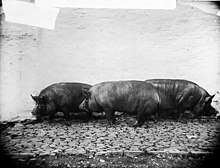
Pigs are part of the mixed farming economy. Traditionally every farm kept a pig as part of the staple diet.[8] During the winter, the main source of meat was cured ham and bacon from pigs raised on the farm.[2] Hams were cured in the large chimneys of farm kitchens, which slowly dried the ham and bacon after it had been salted.[2] This tradition has largely died out, but the remaining producers make hams which are similar to Bayonne, Serrano, or Parma hams.[10] Freshly cured ham is sliced for grilling, older ham is boiled as a York ham, and ham cured for many months is sliced wafer thin, like Parma ham. Carmarthen ham has a similar delicious farmyard flavour. The hocks have the greatest flavour, and need to be boiled a long time to soften the meat. They make a good base for winter stew, or a summer ‘paysanne’ salad.[2] Dry-cured Carmarthen Ham can be found at Carmarthen Market. Five generations of the Rees family have sold ham here [11] spanning 200 years.[12] and their family were the first commercial producers of dry-cured ham in Britain.[8] Carmarthen Ham is dry salt-cured and then air dried and sold whole boneless, or sliced thinly and vacuum packed.[11] Legend has it that when the Romans settled in Carmarthen they stole the recipe and on their return to Italy called it Parma Ham.[11] The ham is cut in thin wafers and is served like prosciutto or Parma ham, but is saltier.[3] Carmarthen Ham production remains a cottage industry, in order to keep it a premium product.[11] Carmarthen Ham is a particular favourite of the Prince of Wales.[12] The Rees family also produce a short back and streaky bacon. This is dry-cured for one week and hung for a further three weeks. It is recommended that the bacon is blanched before frying to remove any excess salt.[2] The Rees family have more than 80 hams curing at any one time,[13] and it takes nine months to cure [13] they also have a mail order business and travel to the nearby markets of Brecon, Fishguard, Haverfordwest, Pembroke and Cardigan.[3]
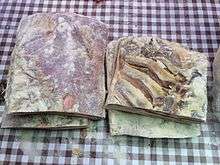
Recipes for Carmarthen ham include: ‘Country Ham with Vegetable Stew’, ‘Pancakes stuffed with Carmarthen Ham and Wild Mushrooms with a savoury Custard’, and ‘Salad Paysanne with Carmarthen Ham and Lentils,’ and ‘Carmarthen Ham in Beer’ [2] Carmarthenshire Ham has featured on Rick Stein’s “Food Heroes” [7] The Welsh chef Dudley recommends pork wrapped in Carmarthenshire ham [14] At the Royal Welsh Show 2010, Carmarthenshire Ham was included in the new European Protected Food names initiative for Protective Geographical Indication (PGI) status, which would give European Union legal status to Carmarthenshire Ham.[15]
Carmarthen Market also sells home-made brawn, sausages, pork pies, and faggots.[1] Faggots can be bought at Ettie Richardson's Home Baking stall, which sells them fresh every Wednesday, Friday and Saturday.[3] A & G Williams of Felinfoel produce traditional Welsh faggots and other savoury products.[8] Brawn is a traditional Carmarthenshire dish, and one Carmarthenshire recipe includes pig's head and trotters which are rubbed well with salt and then fitted neatly into a crock and left for 2 or 3 days. The meat is then washed in cold water, placed in a big boiler pan, brought to the boil and then simmered for 3–4 hours until the meat leaves the bone. The meat is then minced with onions, sage and pepper and then, the liquor strained, and then the mixture simmered for about 15 minutes and then left to cool.[16]
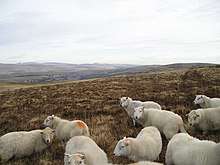
Fets y Cybydd, or the Miser's Feast, was a very popular dish in Carmarthenshire 100 years ago. It was made in a saucepan, but can also be made in a casserole. The bottom of the dish is covered in peeled potatoes, and a sliced onion, with a little salt, covered with water and then brought to the boil. When the water is boiling, a few slices of bacon or apiece of ham are placed on top. The lid is replaced and the whole simmered until the potatoes are cooked, and the water absorbed. The miser was supposed to eat the potatoes one day, mashed up in the liquid, keeping the slices of bacon to be eaten the next day with plain boiled potatoes.[17]
The poet Lynette Roberts, who spent her final years from 1989 in Ferryside and is buried in the churchyard in Llanybri, wrote about making cawl in her Poem from Llanybri (1946), as follows:
In the village when you come. At noon-day
I will offer you a choice bowl of cawl
Served with a 'lover's' spoon and a chopped spray
Of leeks or savori fach...
The Marketing and Tourism department of Carmarthenshire County Council has developed a Cawl Crawl, this is a themed route that people can follow and includes establishments in Carmarthenshire that make their own individual variations on the traditional cawl dish.[18][19]
Fish
Carmarthen Bay sweeps from Gower to Tenby and is the delta for the Carmarthenshire rivers which have excellent fishing: the rivers Towy, Teifi, Afon Cothi and Taf.[2] The ancient craft of coracle fishing can still be seen on the river Teifi, especially between Cenarth and Cilgerran, and on the river Towy near Carmarthen.[3]
Sewin is the prince of Welsh fish.[2] They feed more locally than salmon and hence are more distinctive from region to region, with a pale, pinky flesh and a high oil content.[2] The season begins around Easter and ends in the summer, with the largest fish having the earliest run up the rivers.[2] Sewin range in size from less than a pound in weight to 3 lbs, known as shiglin (the smallest) and twlpin (the larger) in late July and August, to fully grown fish known as gwencin, which equal a salmon in size and come in May or June, or earlier, and again in September.[16] Large sewin can be distinguished from salmon by the tail: the tail is more deeply indented, the colour is browny-grey instead of blue-grey, and the body is slimmer near the tail.[16] Welsh anglers claim that the Tywi yields more sewin over 10 lbs than every sea-trout river in England and Scotland put together.
_for_sale_at_Swansea_Market.jpg)
Raymond Rees, at Carmarthen Market, has iced fish slabs with fresh fish from the coast and the Towy river. He specialises in sewin.[2] He also has one of the few licenses to fish with a coracle on the Towy.[3] This is the longest river entirely within the county.[4] Sewin has a more delicate flavour than salmon and is best cooked simply: grilled or baked gently with plenty of salty Welsh butter. The butter on the hot flesh brings out the flavour, and the rough texture of locally baked brown bread contrasts well with the smooth flesh of sewin. To tell if a whole sewin is of good flavour, the colour of the flesh should be examined by requesting the fishmonger to make a tiny incision with a knife point in the middle of the back of the fish. The flesh should be a clear pink, not a pale or fawny pink, which suggests that the fish has been in the river too long. Big sewin can grow out of their taste and become flavourless, these fish are better stuffed.
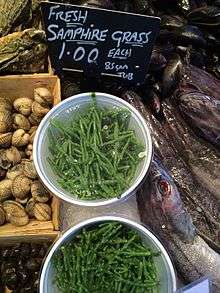
If a sauce is used, then fennel is the best herb to add, and grows wild along the west coast of Wales; an alternative is a cucumber sauce or samphire which grows on the Loughor estuary.
Sea food
Mussels are gathered by hand from Carmarthen Bay and are best in the winter time, when there is an ‘R’ in the month. September to April is the traditional mussel (and oyster) season.[2] Cockles are gathered in the Burry Inlet, but mainly on the Gower side (see Cuisine of Gower). However, Les Parsons, a native Laugharne, returned home after having served in India in 1947 and started his own shellfish business on the Carmarthenshire side of the estuary.[20] This was around the time that Dylan Thomas was resident, and writing about the “web-footed cocklewomen of Laugharne”.[20] Les Parson experimented with bottling cockles in vinegar, to enable them to be sold further afield, and established Parson's Pickles.[20] The firm uses Laugharne Castle as part of its corporate identity because the original factory was located in a mill close to the castle.[20] The company now operates out of Burry Port and produces cockles, mussels, shellfish and pickles, to traditional recipes and European Union accreditation standards.[20]
Cheese

The Farmhouse Cheese Shop, run by John and Patrice Savage-Ontswedder, can be found in Carmarthen Market. They have their own range of Teifi Cheeses and Glynhynod Caerphilly, together with almost all the other cheeses made in West Wales.[3]
Teifi Cheese is an organic vegetarian cow's milk cheese[21] with a bright yellow interior and sweet fruity flavour when young. As it ages, the cheese becomes hard and flaky.[21] It is similar to Gouda and can be eaten on its own, or used in recipes where it adds richness and depth.[21] The flavour is influenced by the grasses growing in the Teifi valley.[21]
John and Patrice Savage-Ontswedder also produce Celtic Promise, a modern vegetarian surface-ripened cow's milk cheese with a semi-soft texture and a moist orange-red rind with a dusting of mould.[21] It is washed in cider brine during ripening and is creamy, rich and yellow with a pungent aroma and piquant taste.[21] This cheese, together with another of their cheeses, known as Saval have been champions at the British Cheese Awards.[7] Celtic Promise complements cider, ale and medium-bodied wines.[21]
Llanboidy Cheese was made on an organic farm near Llanboidy, it was the only cheese in Europe made from the milk of Red Poll cows, a rare pedigree breed grazing traditional pastures and drinking from the farm well.[21] This gave the cheese a fresh-cut hay aroma and sharp, grassy tang.[21] It was made by hand and allowed to develop and mature in its own rind.[21] It had a smooth, silky texture and robust taste.[21]
Other Carmarthenshire cheeses include Caws Cenarth and Kid Me Not, both winners of prizes at the British Cheese Awards.[5] Caws Cenarth supplies Perl Las blue organic cheese to England's Twickenham rugby stadium and has also supplied British Airways.[5]
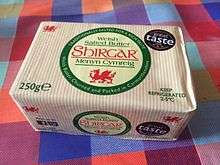
Condiments
Kite Wholefoods, of Pontyberem, are artisan producers of organic mayonnaise.[9] Pencae Mawr Farm Foods of Llanfynydd, Carmarthen, produce home-made chutneys, preserves and other condiments and are True Taste Award winners winning a gold medal for best organic product (beetroot relish) and a silver award for speciality product (blackcurrant and vanilla).[9] Cakes and sweets
“Popty Bach-y-Wlad’ which means ‘little baker in the countryside’ is a traditional bakery run by Enfys Marks at Carmarthen Market, baking Welsh Cakes, Bara Brith, teisen lap (the Welsh plate cake), boiled cake and a range of assorted breads, cakes and buns. At Pobdy Stephens Bakehouse, also art Carmarthen Market, can be found Welsh cakes, sultana pancakes, chunky pasties and Victoria sponges.[3]
The Richardson family of Llansteffan have a shop in Carmarthen Market selling Etta's Royal Cake.[7] The family firm was set up in the 1970s by Etta Richardson [7] Etta's Royal Cake is a favourite of the Prince of Wales, eight cakes were delivered to Highgrove one Christmas, and the cake was ordered by Queen Elizabeth II for the wedding reception of Prince Charles and Camilla.[7] Fiona's Fudge, in Carmarthen, produces home-made fruit cakes and fudge.[8] In Llandovery, organic fudge, biscuits and cakes are made by Just So Scrumpitious/O Mor Braf without using preservatives and gift packaged.
Mario’s Ice Cream, produced by Mario Dalavalle, a third generation ice-cream maker, was awarded the National Ice Alliance Silver Shield in 2007 for the best dairy ice cream in Great Britain.[22] He produces 30 varieties of ice cream at his dairy in Crosshands.[13] All the milk comes from a 15 mile radius of his dairy, including the Nant-y-Bwla pedigree Jersey herd, and the Gwendraeth Valley’s Cwmheidir Farm, gold medal winners at the Royal Welsh Show.[13] Mario points out that cheap ice cream is full of air and vegetable fat, he believes the reason that his business has grown is because people are willing to pay more for quality.[13] Mario’s Ice Cream is available across Wales and at Asda stores.[13] Another national ice cream award winner is Frank’s Ice Cream [5] produced for the last 80 years from Capel Hendre, Ammanford, it is available from Tescos and has won the British, European and Champion of Champions’ cup.[23] and produces a diabetic vanilla ice cream [24] Tregoes Waffle Bakery, of Llandysul, produces sweet waffles based on traditional recipes.[8]
Brynderi Honey Farm, of Whitland, are honey producers and international organic honey packers from farm produced honey to honey harvested from organic-certified hives. They also produce honey ice-cream and marmalade.[9]
Drink
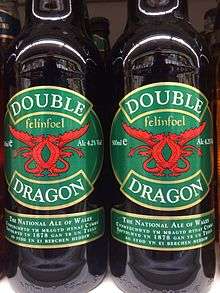
Felinfoel Brewery Company based at Felinfoel, Llanelli, is a traditional brewery noted for cask ale and bottled beer.[8] It was founded in 1840 and invented canned beer in 1935.[3] Its Double Dragon beer is distributed as far as the United States, Germany and France.[3] Evan Evans Brewery is a brewery based in Llandeilo producing ale called Cwrw, which is Welsh for beer.[4] The Towy Valley Cider Company is based in Carmarthen [25] Their cider is made to a traditional recipe using apple juice pressed on the farm. It is matured in oak barrels and then kept for at least a year before distribution, which makes it a strong, clear, still cider.[3]
Brecon Carreg is a natural spring water which is either still or sparkling, and is produced at Trap, Carmarthenshire.[8]
Other markets and box schemes
Other markets include Ammanford street market (every Friday), Llandeilo open air market (every Friday), Carmarthen farmers’ market (first Friday of every month), Llandovery market (last Saturday of every month), Ammanford farmers’ market (last Thursday of every month).[7]
There are 3 large scale food & drink festivals held at Carmarthen Showground in Carmarthen, showcasing the best in Season of the counties food, drinks and crafts: The Winter Show, The Spring Show and the Summer Show. www.wintershowwales.co.uk
Box schemes are provided by Organics to Go, based at Golden Grove, near Llandeilo, which includes specific items to order and delivers throughout South and West Wales.[9] M & M Organics of Pontyberem, Llanelli run a box scheme covering Carmarthenshire and Pembrokeshire areas.[9] The Organic Pantry, based in Ammanford, does door deliveries.[9]
See also
- Welsh cuisine
- Cuisine of Ceredigion
- Cuisine of Gower
- Cuisine of Monmouthshire
- Cuisine of Pembrokeshire
Further reading
- Welsh Fare - website by National Museum Cardiff based on their book printed in 1976 containing recipes selected by S. Minwel Tibbott in respect of the Cuisine of Wales
External links
- Carmarthen Food on-line local produce market for Carmarthenshire
- Visit Carmarthenshire web site of Carmarthenshire Tourism Association with section on local food
- Hungry City Hippy - 48 hours in Carmarthenshire a food lover’s itinerary a Cardiff food blogger’s report on Carmarthenshire food
- Grown in Wales web site dedicated to food and plant growers in Wales with regional guide including Carmarthenshire
- Olive Magazine, Foodie road trip in Carmarthenshire article on places to eat and drink in Carmarthenshire
- Clare Hargreaves food blog The chic face of Carmarthenshire - article on Carmarthenshire food
- Carmarthen market market web site with list of food stalls and cafes
- Wright’s Food Emporium review by The Guardian
- Wright’s Food Emporium review by WalesOnline (Media Wales)
References
- "Archived copy". Archived from the original on 2008-07-06. Retrieved 2010-08-10.CS1 maint: archived copy as title (link) Retrieved 7 August 2010
- Pressdee, C., ‘Colin Pressdee’s Welsh Coastal Cookery, BBC Books, 1995, ISBN 0-563-37136-6
- Davies, G., “A Taste of Wales”, Pavilion Books Limited, 1995, ISBN 1-85793-293-5
- https:/t/www.telegraph.co.uk/sponsored/travel/visitwales/6163419/Carmarthenshire-Visit-Wales.html Retrieved 7 August 2010
- "Archived copy". Archived from the original on 2011-07-07. Retrieved 2010-08-10.CS1 maint: archived copy as title (link) Retrieved 7 August 2010
- http://view.vcab.com/?vcabid=eglSrenrSgecln Retrieved 7 July 2010
- "Archived copy". Archived from the original on 2011-07-10. Retrieved 2010-08-10.CS1 maint: archived copy as title (link) Retrieved 7 August 2010
- Pressdee, C., ‘Food Wales, A Second Helping, Graffeg pub., 2005, ISBN 978-1-905582-15-0
- Organic Centre Wales, “Local Organic, Where to buy fresh, local organic food and drink in Wales 2008-9”, sponsored by the Welsh Assembly Government
- http://www.timesonline.co.uk/tol/life_and_style/food_and_drink/article588607.ece Retrieved 10 August 2010
- http://www.carmarthenham.co.uk/contact.htm Retrieved 7 August 2010
- http://www.walesonline.co.uk/news/wales-news/2010/01/23/princess-royal-praises-carmarthen-91466-25667938/ Retrieved 8 August 2010
- "Archived copy". Archived from the original on 2011-06-15. Retrieved 2010-08-10.CS1 maint: archived copy as title (link) Retrieved 8 August 2010
- "Archived copy". Archived from the original on 2008-07-19. Retrieved 2010-08-10.CS1 maint: archived copy as title (link) Retrieved 8 August 2010
- http://www.walesonline.co.uk/news/wales-news/2010/07/22/bid-to-win-special-status-for-welsh-food-91466-26905144/ Retrieved 10 August 2010
- Freeman, B., "Traditional Food From Wales", Hippocrene Books, 1997, ISBN 0-7818-0527-9
- Anon., Croeso Cymreig, a Welsh Welcome: Recipes for some Traditional Welsh Dishes’, John Jones Publishing Ltd., 1979,
- http://www.discovercarmarthenshire.com/explore/carmarthenshire-cawl-crawl/ Retrieved 6 January 2020
- https://www.walesonline.co.uk/whats-on/food-drink-news/cawl-crawl-welsh-traditional-food-8715911.amp Retrieved 6 January 2020
- http://www.parsonspickles.co.uk/about/ Retrieved 7 August 2010
- "Welsh Cheeses". www.ilovecheese.co.uk.
- "Archived copy". Archived from the original on 2010-08-19. Retrieved 2010-08-10.CS1 maint: archived copy as title (link)
- http://www.dooyoo.co.uk/food/frank-s-diabetic-ice-cream/1272140/ Archived 2010-05-01 at the Wayback Machine Retrieved 7 August 2010
- http://www.ciao.co.uk/Frank_s_Ice_Cream_Diabetic_Vanilla__7055029 Archived 2010-08-23 at the Wayback Machine Retrieved 7 August 2010
- http://www.tastingbeers.com/directory/detail/towy_valley_cider.37824.html Retrieved 10 August 2010
.jpg)
